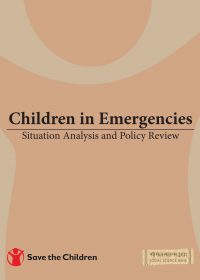Publications
Children in Emergencies: Situation Analysis and Policy Review
Nepal experiences a wide variety of natural disasters, namely, floods, landslides, earthquakes and weather extremities in the form of cold waves every year, leading to destruction of physical property as well as loss of lives. The degree and intensity of the consequences of disasters vary along age, gender and various other social factors. Among children, who are one of the groups made most vulnerable by disasters, the negative effects are even more pronounced as they have the least capacity to raise their voice, and it is often the case that issues specific to children are overlooked as there persists a general tendency to couple their priorities with those of other vulnerable groups. Disasters impact children’s physical safety, undermine their health and nutrition needs, interrupt education, compromise parental care, introduce protection risks, and harm their psychosocial wellbeing. In this context, Save the Children commissioned this study to explore and document the effects of disasters on the children aged 0-8 and the challenges their caregivers are faced with, and provide recommendations to mitigate those effects while providing protection to this most vulnerable of groups.

